Ouyen was chosen as the
venue due to considerable increase in interest in Malleefowl following recent
sightings of large numbers of birds feeding on roadsides in the local area.
The weekend commenced on
Saturday with a public information session held at the recreation reserve. Dr Jo Benshemesh gave a comprehensive
overview of the work of VMRG, the history of monitoring and numbers of birds
recorded over time. He touched on
reasons why numbers have spectacularly increased and how abundant food sources
found on the roadside (canola from grain carting vehicles) have affected the
Malleefowl behaviour

Formal reporting back was
carried out at the harness racing pavilion, with a delicious lunch provided by
local community groups. Jo Benshemesh
highlighted the main information recorded on the National Malleefowl Data base
and confirmed that numbers of active Malleefowl mounds have increased
dramatically. Jo also stated that the
research and monitoring is showing that there appears to be no correlation
between fox baiting and fluctuations in Malleefowl numbers.
Melbourne University
researchers gave a presentation on the early stages of their research project
on Adaptive Management of Malleefowl.
The VMRG submission in
response to Fire Operation Plans for the Mallee was outlined, with major
concerns regarding the 5% target critically impacting on biodiversity and
Malleefowl habitat. Particular concern was highlighted where areas burnt by
wildfire are not included in the burn target.
Ron Wiseman presented a
motion camera sequence from a Malleefowl mound in Wathe reserve showing fox
activity removing chicks, whole eggs and returning multiple times over several
hours. In between fox visits the birds
stoically returned and kept tending the nest.
President of VMRG Peter
Stokie reported that the annual training weekend had gone very well this year
with fourteen new monitors trained.
On Sunday twenty people
visited the Iluka Mining Offset vegetation blocks on Tony and Bev Bingleys
property adjoining the Annuello Flora and Fauna reserve. This area has not been searched for
Malleefowl mounds, but tracks are frequently seen. A fire break was recently constructed as part
of the management plan, which revealed a working nest beside the track. We sighted a Malleefowl in the offset block.
The reporting back weekend
was a valuable opportunity to learn more about the VMRG activity over the past
year. It was encouraging to see
community interest and involvement with the activity, and to view the area that
may be searched sometime in the future.
Article and photograph by Annette
Robertson, photograph – members of the VMRG








